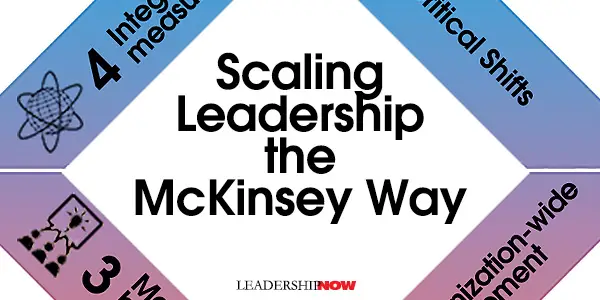 |
 |
06.19.19

Scaling Leadership the McKinsey Way
BEFORE YOU BEGIN your next leadership development program, read this. It is not uncommon to hear leaders complain that leadership development programs are not delivering the effective leaders necessary to execute their strategies and purpose. While there is no end of leadership advice, it doesn’t always translate into leaders that can deliver the results the organization needs. In Leadership at Scale, McKinsey partners Claudio Feser, Michael Rennie, and Nicolai Chen Nielson share the McKinsey method for developing more and better leaders across an organization. “Scale implies touching a critical mass of leaders and employees to reach a tipping point—after which point the change become self-sustaining and the organization fundamentally changes how it leads.” To begin, to improve leadership effectiveness in an organization as a whole, it is imperative that leaders “think at an organizational, system-wide level, and the approach one takes to do this differs markedly from that of increasing the effectiveness of individual leaders.” The McKinsey approach is founded on four beliefs that constitute effective leadership: 1. Leaders align, execute and renew. “Leaders make decisions about people and direction (alignment); they see that their intent is carried out (execution); and they think about the next evolution of activity (renewal).” Renewal refers to the constantly changing environment. “Organizational contexts have and will always be changing, and a key element of leadership is thus to display resilience and agility in order to continue to thrive.” 2. All leadership takes place within a context. “We strongly believe that there is no such thing as standard leadership behavior that works irrespective of contextual factors, such as corporate strategy or the level of hierarchy of a given position.” 3. Skills built through real-life experience enable effective leadership behaviors. “Great leaders’ skills are forged on-the-job, and the experience and skills that leaders have accumulated help them display more effective leadership behaviors.” 4. Leaders must develop the right mindsets based on introspection and self-awareness. “We focus on mindsets because mindsets ultimately drive behaviors. Making one’s mindset the subject of conscious scrutiny is an indispensable prerequisite of leadership effectiveness.” That leads us to the Leadership at Scale Diamond. Leadership at Scale Diamond Underpinning the McKinsey approach are four core principles they call the Leadership at Scale Diamond. These principles must exist to increase leadership effectiveness across an organization.
Core Principle 1: Focus on the critical shifts that drive disproportionate value. Link leadership development to the organizational context and strategy and focus on the three to five shifts (behaviors, skill, and mindsets) that will have the biggest impact on performance. Surprisingly, leadership development is often not aligned with the organization’s purpose and strategy. In their research, executives have told them that “their organizations have not translated their strategy to their needs.” Instead, they have used “generic and broad competency models.” The result is not surprising. Their research identified three categories of leadership behaviors: Baseline Behaviors: Effectiveness at facilitating group collaboration, Demonstrating concern for people, Championing desired change, and Offering Critical perspectives. These behaviors apply in any context, but they by themselves do not differentiate between mediocre and top performance.
McKinsey also concluded that only a few behaviors drive organizational performance and that varies by context. So, in addition to context-specific behaviors is the ability of a sufficient number of leaders in an organization to be able to rapidly adjust to different situations and the accompanying behaviors. Core Principle 2: Engage a critical mass of pivotal influencers across the organization to reach a tipping point. Organizations must ensure sufficient breadth, depth, and pace in order to change leadership behaviors across the organization, and to give all employees an understanding of what great leadership looks like. Pivotal influencers are those 5 to 15% that others look to for cues as to what success looks like in the organization. Work first with these people with the understanding that developing a repertoire of leadership capabilities takes time. And of course, the training should reflect that truth. Core Principle 3: Architect programs that maximize behavioral change based on neuroscience. Design interventions with an explicit focus on helping individuals become “better at their daily jobs” using the latest principles linked to neuroscience, to maximize the value and organizational impact of what is taught and learned. Rather than just the teach and classroom approach, leaders need to practice the new behaviors. McKinsey designs programs around seven adult learning principles:
Core Principle 4: Integrate and measure the program in the broader organization Organizations must ensure that the broader ecosystem directly supports and reinforces the shift in behaviors, skills, and mindsets that the leadership development program promotes. You can’t run a leadership development initiative in isolation and expect positive results. The culture of the organization must support it or enable the new behaviors that the organization needs both formally and informally. The authors note that the actual capability building journey is only 25% of what is required. “People’s behaviors are heavily influenced by their broader context, and in order to sustainable shift their behaviors, you need to shift the context.” In part two of the book, they share this approach in practice. It is quite comprehensive, and the case studies are instructive. 
Posted by Michael McKinney at 07:39 AM
|
BUILD YOUR KNOWLEDGE
 

How to Do Your Start-Up Right STRAIGHT TALK FOR START-UPS 
Grow Your Leadership Skills NEW AND UPCOMING LEADERSHIP BOOKS 
Leadership Minute BITE-SIZE CONCEPTS YOU CAN CHEW ON 
Classic Leadership Books BOOKS TO READ BEFORE YOU LEAD |